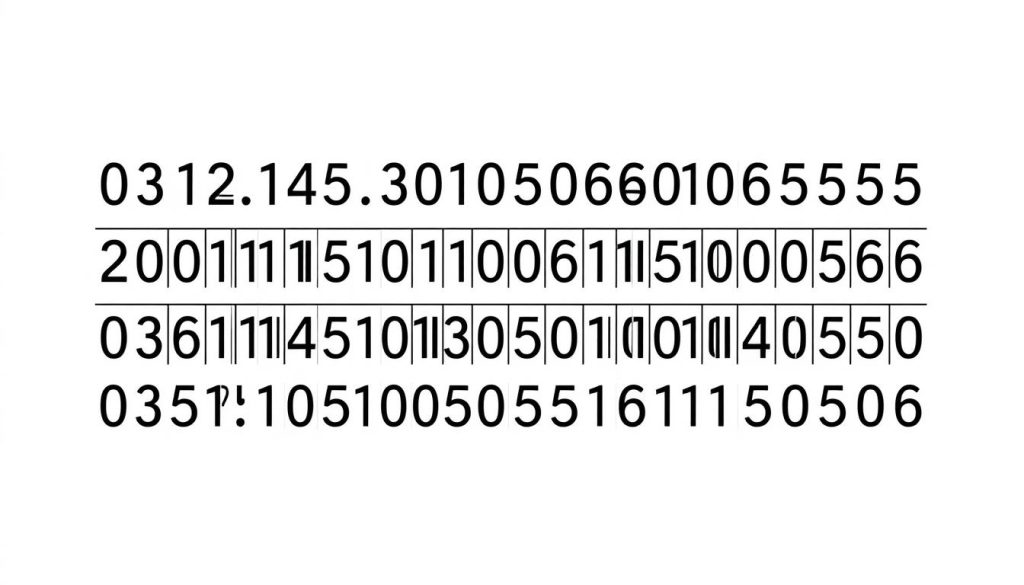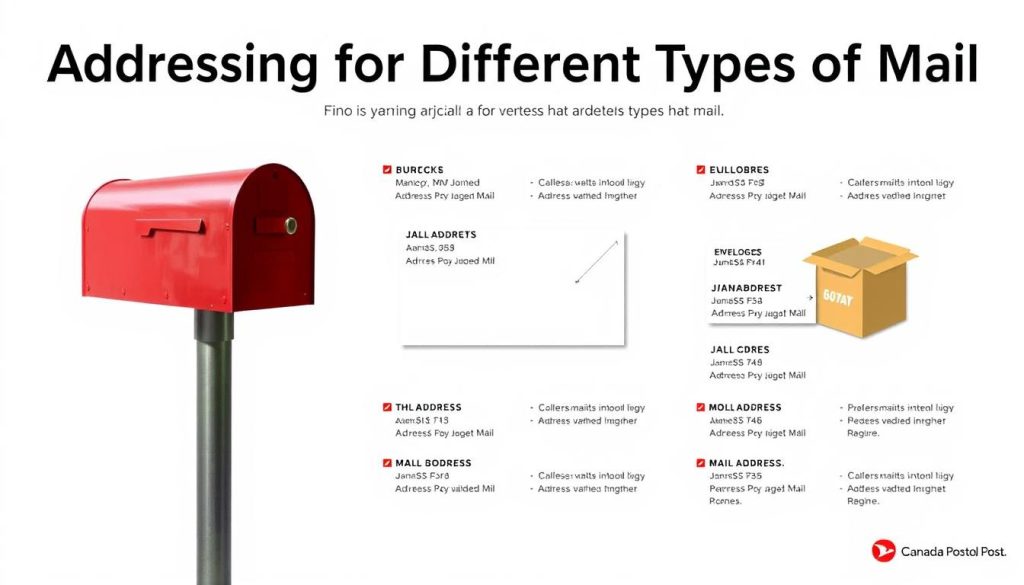Ever wondered why your mail might get lost or late? The key to perfect mail delivery is knowing how to address envelopes for Canada Post.
It might seem easy to write an address on an envelope. But Canada Post has special rules that really help. These rules make sure your mail gets to where it needs to go fast and right.
Properly addressing an envelope is more than just writing an address. It’s about following exact rules that help postal workers. This is true whether you’re sending a letter or business mail. Knowing the right way to address can save you time and avoid delivery problems.
Key Takeaways
- Accurate addressing is critical for successful mail delivery
- Canada Post has specific formatting guidelines
- Proper addressing reduces mail processing time
- Consistent formatting helps prevent delivery errors
- Understanding postal codes is essential
Understanding the Importance of Addressing
Proper addressing is key for fast mail delivery in Canada. Following the mailing address format Canada guidelines helps your mail get to its destination fast. Canada Post’s addressing rules are not just rules. They are a vital system for smooth communication.
Why Addressing Matters
Accurate addressing is very important for postal efficiency. Your well-written address helps postal workers sort mail. This makes delivery better in many ways:
- Reduces processing time
- Minimizes delivery errors
- Helps lower costs
- Supports the environment
Consequences of Incorrect Addressing
Mistakes in your mailing address can cause big problems. Wrongly addressed mail can face many issues. These can upset both the sender and the receiver.
| Addressing Error | Potential Consequence |
|---|---|
| Incomplete Address | Returned to Sender |
| Incorrect Postal Code | Delayed Delivery |
| Misplaced Street Name | Undeliverable Mail |
| Missing Apartment Number | Mail Sent to Wrong Location |
By using precise addressing, your mail will get to its destination well. Attention to detail is very important for successful mail delivery.
Basic Elements of an Envelope
When you send mail in Canada, knowing the envelope basics is key. Canada Post has rules to help your mail get there right.
Let’s look at what makes up a basic envelope for sending mail in Canada.
Front vs. Back of the Envelope
The front of the envelope is where you write the address. It has important info for postal workers:
- Recipient’s full name
- Complete street address
- Canadian postal code format
- City and province
The back of the envelope should be empty. It’s for return addresses or postal marks.
How to Select the Right Envelope Size
Picking the right envelope size is important. Canada Post has a few standard sizes:
- Standard business envelope: 4⅛ x 9½ inches
- Large envelope: Up to 12 x 15 inches
- Catalog/booklet envelope: Larger sizes for documents
Choosing the right size affects postage and delivery. Make sure the envelope fits your mail and the postal code is easy to see.
Proper Address Format for Canada Post
When you send mail through Canada Post, it’s key to use the right address format. This helps your package get to where it needs to go. You need to pay close attention to the details and follow certain rules.
To understand Canada Post’s delivery standards, you must know how to write addresses. This involves several important parts. Together, they make your address clear and easy to read.
Recipient’s Name and Title
Here are some rules for writing the recipient’s name:
- Use the full legal name of the recipient
- Add professional titles if needed
- Choose the recipient’s preferred name or greeting
- Don’t use nicknames or informal names
Street Address Guidelines
Canada Post has specific rules for street addresses:
- Write the street address in UPPERCASE LETTERS
- Put apartment or unit numbers before the street name
- Spell out street types like STREET, AVENUE, ROAD
- Try not to use abbreviations
City, Province, and Postal Code Details
The last part of your address needs important location info:
- Write the city name in mixed case
- Use the two-letter provincial abbreviation
- Include the postal code with a single space between province and code
By following these guidelines, you’ll make sure your mail gets to its destination fast and right.
Using Postal Codes in Canada
Understanding the Canadian postal code system is key. It helps your mail get to the right place. Knowing how to write postal codes is very important.

Canadian postal codes have a special six-character pattern. They mix letters and numbers. This makes it easier for Canada Post to sort and deliver mail.
Structure of Canadian Postal Codes
Each postal code has six characters. They follow a pattern of letters and numbers. Here’s how it works:
- First character: A letter for a region
- Second character: A number for a specific area
- Third character: A letter for a local postal district
- Fourth character: A number for a street or block
- Fifth character: A letter for a delivery point
- Sixth character: A number for final sorting
Formatting Postal Codes Correctly
Here’s how to write a postal code:
- Use uppercase letters
- Put a space between the first and last three characters
- Don’t use hyphens
- Write the postal code after the city and province
For example, a correct postal code is M5V 2T6. Not MV5 2T6 or M5V-2T6.
Additional Information to Include
When you send mail through Canada Post, it’s important to format your envelope right. The details you add can affect your mail’s journey.
Your return address is key for mail communication. It helps if your mail can’t be delivered.
Return Address Placement
The return address goes in the top-left corner of your envelope. Here’s what to do:
- Write your full name
- Include complete street address
- Add city, province, and postal code
- Use clear, legible handwriting or printed text
International Mail to Canada Addressing
When sending mail internationally to Canada, pay close attention. The rules are different from domestic mail.
| International Mailing Requirement | Specific Details |
|---|---|
| Language | Use English or French |
| Address Format | Follow standard Canada Post international addressing guidelines |
| Postal Code | Include full six-character postal code |
| Country Name | Write “CANADA” in capital letters |
By following these guidelines, your mail is more likely to reach its destination smoothly.
Addressing for Different Types of Mail
Learning how to write an address on an envelope for Canada Post is important. It matters whether you’re sending a letter or a package. Each type has its own rules to make sure it gets there right.

Every mail type needs its own way of being addressed. Where and how you write the address can really help it get delivered.
Personal Letters: Intimate Communication
For personal letters, remember these tips:
- Write the recipient’s full name clearly
- Use legible handwriting or printed labels
- Place the address in the center of the envelope
- Ensure proper postal code formatting
Business Mail: Professional Precision
Business mail needs to be more formal:
- Include the company name (if applicable)
- Use the recipient’s full professional title
- Verify the exact departmental address
- Maintain a clean, professional appearance
Packages and Large Envelopes: Special Considerations
Bigger mail needs extra care with the address:
| Mail Type | Addressing Requirements |
|---|---|
| Packages | Clear, large font addressing |
| Large Envelopes | Horizontal address placement |
| Fragile Items | Additional handling instructions |
Pro tip: Always double-check your address details to prevent delivery delays. Accuracy is key in Canada Post envelope addressing.
Tips for Neat and Legible Addressing
Proper envelope addressing in Canada needs careful attention. Clear and easy-to-read addresses help your mail get to the right place fast. Canada Post says it’s key to make addresses that both people and machines can read.
When you address an envelope, you can write it by hand or print it. Each way has its own good points and challenges for proper envelope addressing in Canada.
Handwriting vs. Printed Addresses
- Handwriting:
- Best when using dark ink (blue or black)
- Write clearly and legibly
- Use uppercase letters
- Printed Addresses:
- Recommended for business correspondence
- Ensures consistent and clear text
- Easier for automated sorting
Font and Style Recommendations
To meet Canada Post addressing guidelines, follow these font and style recommendations:
- Use standard sans-serif fonts like Arial or Helvetica
- Maintain font size between 10-12 points
- Avoid decorative or script-style fonts
- Ensure high contrast between text and envelope color
By following these tips, you’ll make addresses that are easy to read. They will also work well with Canada Post’s systems. This helps avoid delivery delays or mail going to the wrong place.
Common Mistakes to Avoid
When you send mail in Canada, you must be very careful. Small mistakes can stop your mail from getting where it needs to go. Knowing the common mistakes helps make sure your mail gets there safely.
- Incorrect postal code placement
- Using unnecessary punctuation
- Improper abbreviations for provinces
- Mixing uppercase and lowercase letters
Misplaced Information Pitfalls
Your mailing address in Canada must be just right. Putting the postal code or street name in the wrong spot can mess things up. Always check that everything is in the right place.
Ignoring Canada Post Guidelines
Canada Post rules are not just suggestions. They are very important. Breaking these rules can make your mail come back or be very late. Some big mistakes are:
- Writing addresses in script or cursive
- Using colored ink that’s hard to read
- Leaving out important parts of the address
- Not using the right two-letter province abbreviations
By avoiding these mistakes, your mail is more likely to get to its destination fast and right.
How to Confirm Address Accuracy
It’s very important to make sure your mailing address is right. Wrong addresses can cause mail to not get delivered. Canada Post has many ways to check and confirm your address.
Finding your way through the canada post addressing guidelines can be tough. But, there are many resources to help you keep your mailing info correct.
Online Address Verification Tools
Canada Post has digital tools to check addresses fast and easy. These tools help you:
- Check postal code validity
- Standardize street addresses
- Confirm municipal information
- Validate address formatting
Direct Contact with Canada Post
If online tools don’t work, you can talk to Canada Post directly. Their customer service team can help with tricky address problems.
| Contact Method | Best For |
|---|---|
| Online Support Portal | Quick address inquiries |
| Phone Support | Detailed address verification |
| Local Post Office | In-person address consultation |
Using these methods, you can make sure your mail gets to where it’s supposed to go.
Final Checklist Before Mailing
Before you mail something through Canada Post, check it carefully. Knowing how to write the address right can help your mail get there fast.
Look over every part of the address on your envelope. Make sure the name, street, city, province, and postal code are all correct. It’s important to check each line for mistakes or missing info.
Before you seal it, check if you have the right postage. Different things cost different amounts to send. Weigh your item and check the rates online or at a post office. This can save you from delays or extra costs.
Do a final check by eye. Make sure the address is easy to read and not smudged. This careful step helps your mail get to its destination quickly and without trouble.
